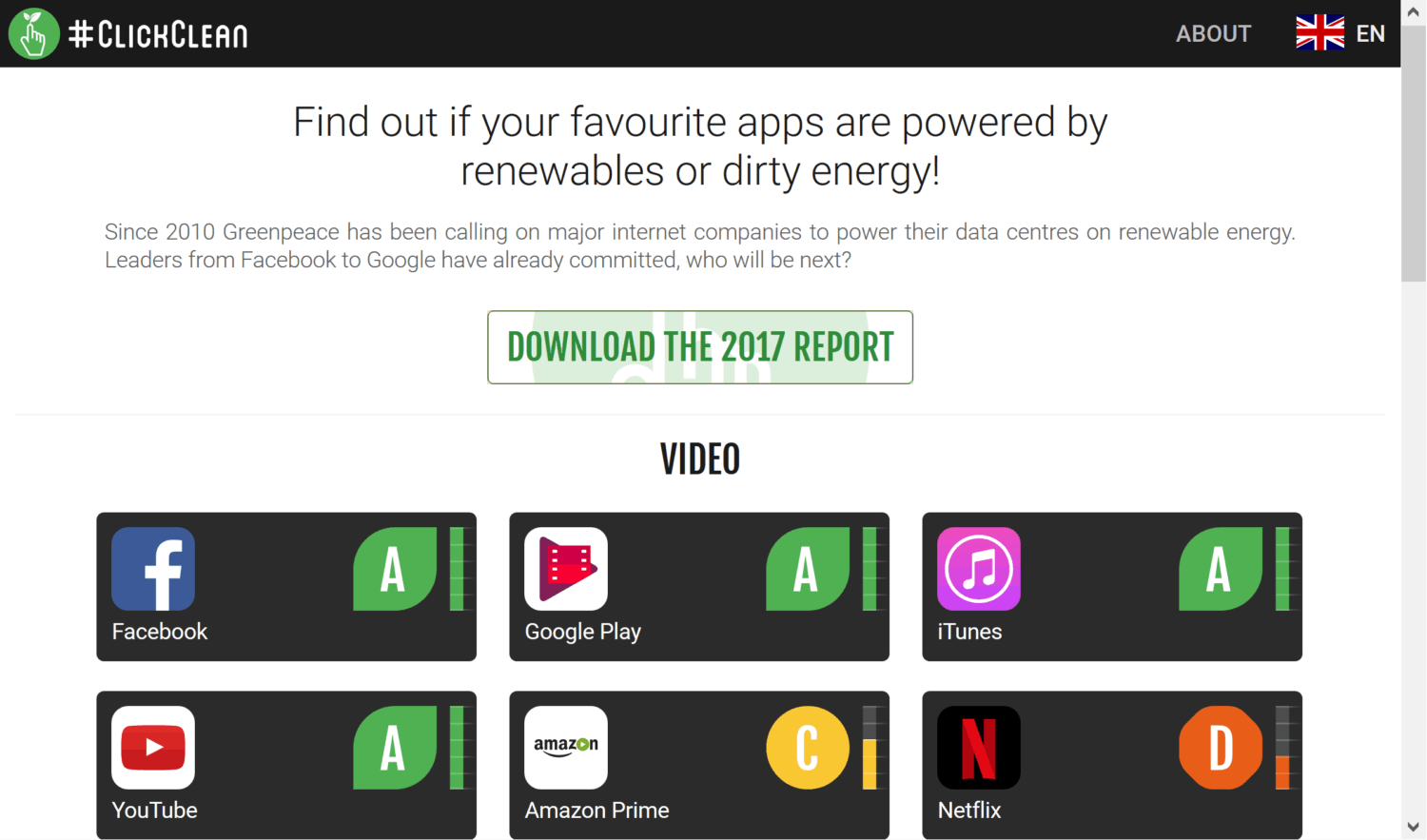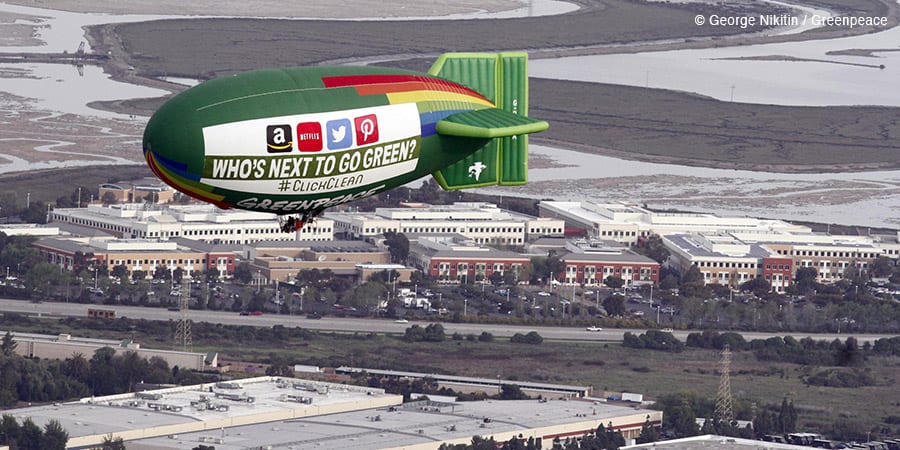 Insight
Insight


Sustainable UX is an annual conference for UX, front-end, and product people who want to make a positive impact, especially on climate change. I tuned in online last week for our developer Jerome’s talk on our website carbon calculator, and I also watched a lot of other interesting talks.
Something that struck me in the conference was that there were several references to Greenpeace’s Click Clean campaign.

Click Clean is a campaign that Greenpeace began in 2010 to shine a light on the immense energy consumption and carbon footprint of some of the world’s biggest tech companies. The campaign has been, in many ways, a great success, helping to motivate companies like Amazon to actively move away from coal power and commit to a future powered by renewables.
It also played a part in raising awareness of the issues of internet energy use and emissions amongst web professionals such as myself, and was an influence in driving us at Wholegrain Digital to embrace sustainability as a central pillar of good web design and development. I believe that Click Clean shows the power that environmental NGOs have to create positive change within our industry, and we need their help to lead this cause now more than ever.
We need environmental NGOs to help lead the way to a sustainable web. This post looks at four ways environmental charities can accelerate the transition to a sustainable web: from leading by example to campaigning for innovative regulations.
We need a sustainable web, and these are some ideas to get us there.
In her recent TED talk, climate scientist Katharine Hayhoe makes the case that the most important thing we can do to fight climate change is to talk about it. This is particularly true in the web industry where carbon emissions are rarely discussed openly. It’s common for people in our industry to have never made the connection between the apparently clean web and the huge amounts of energy required to power the services that we create and use. We as an industry need to be talking about this a lot more, recognising it as an issue that we need to face together and using it as an opportunity to create a better web for everyone.
Environmental charities are perfectly positioned to get a wide range of stakeholders from within our industry and from outside the industry talking about greening the web. They also hold a position of authority in society regarding environmental issues, so it’s somewhat necessary for them to talk about it in order to be taken seriously by the public as a real issue.
Click Clean is the perfect case study of how organisations like Greenpeace can plant the seeds of change within an industry and then help those seeds to grow. What we need now is for more environmental organisations to start talking about web sustainability and helping to open conversations with a much wider audience.
So, now we’ve got environmental charities talking about web sustainability, what’s the next step?
I’m a big believer in leading by example, which is why we redesigned our own website to be far more efficient after we understood its potential carbon impact. Considering that the internet is one of the world’s most polluting industries and that all environmental charities make extensive use of digital technology in their own operations and marketing, there’s a huge opportunity for them to lead by example and demonstrate best practise.
Out of curiosity, we recently benchmarked some of the UK’s best known environmental non-profits to see which of them was following best practice in web sustainability by using renewably powered web hosting and minimising the size of their web pages. I was surprised to find that out of 14 organisations benchmarked, only two appeared to be using hosting powered by green energy: Greenpeace* and RSPB.
Furthermore, in terms of emissions, these environmental charities websites on average were more than four times as polluting as the average website tested in our carbon calculator, and only two of them, the British Ecological Society and the Energy Saving Trust, had emissions lower than our overall average of 2.25 grams per page view. Great to see that the Energy Saving Trust are setting an example in saving website energy!
Here are the full results, which were recorded on 14th February 2019:
| Website | Carbon Emissions (grams CO2 per page view) | Energy for 120K page views (kWh) | Green Energy | Load time (seconds) | Page size (MB) |
| https://friendsoftheearth.uk/ | 10.4 | 2,516 | No | 3.5 | 9.06 |
| https://www.wildlifetrusts.org/ | 15.4 | 3,741 | No | 2.3 | 8.01 |
| https://www.rspb.org.uk/ | 2.8 | 1,230 | Yes | 8.7 | 2.55 |
| https://www.woodlandtrust.org.uk/ | 4.5 | 1,101 | No | 4.6 | 2.35 |
| https://www.greenpeace.org.uk/ | 25.7 | 6,251 | Yes* | 6.1 | 13.5 |
| http://www.energysavingtrust.org.uk/ | 2.2 | 531 | No | 3.3 | 1.1 |
| https://www.sas.org.uk/ | 4.0 | 961 | No | 8.1 | 2.06 |
| https://www.cat.org.uk/ | 13.8 | 3,342 | No | 2.8 | 7.13 |
| https://www.wen.org.uk/ | 6.3 | 1,536 | No | 6.9 | 3.33 |
| https://www.britishecologicalsociety.org/ | 1.9 | 469 | No | 4.5 | 0.96 |
| https://www.wwf.org.uk/ | 15.1 | 3,666 | No | 4.3 | 8.39 |
| https://www.cpre.org.uk/ | 5.1 | 1,243 | No | 6 | 2.76 |
| http://www.keepbritaintidy.org/ | 23.09 | 5,585 | No | 17.7 | 12.2 |
| https://www.carbontrust.com/ | 8.9 | 2,161 | No | 7.9 | 2.56 |
| https://www.soilassociation.org/ | 13.3 | 3220 | No | 10.3 | 6.99 |
| AVERAGES | 10.2 | 2504 | 6.5 | 5.53 |
It’s notable that website efficiency is related to page load speed, illustrated by the fact that the British Ecology Society website is the only one tested to achieve an A grade when tested with Google Pagespeed. This means that a focus on reducing file sizes (especially images) will also help provide a better user experience to people seeking to engage with these environmental organisations.
As we often talk about here at Wholegrain, more sustainable websites are better websites for everyone. By making the simple switch to green hosting providers and prioritising web performance, environmental NGOs can demonstrate leadership in tackling internet emissions and improve engagement with their own website visitors at the same time.
* It’s important to note a couple of anomalies regarding greenpeace.org.uk. Firstly, our carbon calculator couldn’t detect green hosting, but Greenpeace informed us that they are using a green host but the host IP address is hidden behind a CDN. It is worth noting that this could be true of some other organisations too. Secondly, we noted that size of the Greenpeace homepage varied wildly on different days because images on the home page were changed regularly with no standard sizing.
We’ve seen that if environmental organisations take a lead on web sustainability it could actually help lead our industry in best practice while also increasing the effectiveness of their work overall. The next step is to encourage greater transparency.
Connecting these first two points is a need for greater transparency around what we are all doing to achieve web sustainability. Nobody’s perfect and that’s okay, but if we’re to make real progress, then transparency is going to be really important. As organisations, we need to start publishing our own approaches to web sustainability even if that just means saying that we haven’t really got our heads around it yet. Transparency earns trust and opens up dialogue, which then enables us to work together to move forward.
Environmental groups are perfectly positioned to nudge our industry into being more transparent on web sustainability, and if they can set a good example in their own reporting on the issue then it will help others to get on board and follow suit. Publicly listed companies are required to report their emissions from April 2019, so this is a great excuse to start talking about those results and what impact the web plays.
This will be a huge step forward but we also need the involvement of government; and environmental groups can help with that too.
Environmental non-profits have been hugely influential in the creation of environmental regulations around the world. Although I will admit that I am not always a fan of regulations, the protection of our planet is something that I believe can only be ensured with strong and effective government regulation.
Currently, there’s very little in the way of environmental regulation in our sector, which is astonishing considering that the internet is arguably the most polluting machine ever created. These days it is considered not just normal, but actually helpful to be given an energy efficiency rating when buying a new household appliance, buying a new car or even a home, but yet it is almost impossible to obtain information about the efficiency of web hosts or internet services. Wouldn’t you like to see an energy rating when comparing a WordPress hosting plan from WP Engine, with one from Kinsta or GoDaddy?
Environmental groups have extensive knowledge of how to design environmental regulations and how to push them from idea to reality. If progressive players within the industry and non-profits work together, we could foreseeably create regulations that are compatible with business, helping level the playing field and driving the whole sector towards more sustainable solutions.
Environmental groups have been at the forefront of many historic wins for our environment and we live in a far more positive world as a result of their brave and tireless efforts to stand up for what is right.
Greenpeace’s Click Clean campaign in the U.S. has demonstrated the potential for green organisations to accelerate progress towards sustainability in our industry.

Now, with climate change becoming ever more urgent and our industry becoming ever more hungry for energy, we need the support and leadership of these influential organisations around the world more than ever. If we join forces and work together, I believe that we can successfully accelerate the transition to a sustainable web.
If you’d like to discuss ideas of how we can collaborate to create positive change, get in touch with us and let’s start the conversation today 🙂
Originally posted here
Wholegrain Digital were a finalist in the 2019 Impact Awards, in the Sustainable Living Category